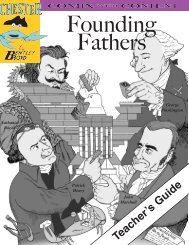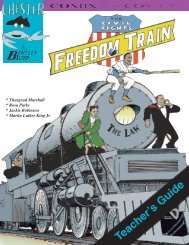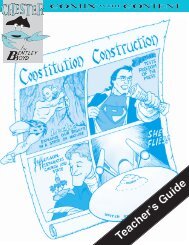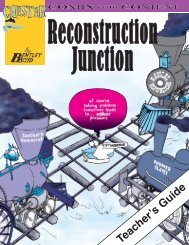Teacher's Guide - Chester Comix
Teacher's Guide - Chester Comix
Teacher's Guide - Chester Comix
You also want an ePaper? Increase the reach of your titles
YUMPU automatically turns print PDFs into web optimized ePapers that Google loves.
(VOCABULARY, continued from previous page )<br />
non-importation (p. 11) – promise to not buy goods made in another country<br />
Lord North (p. 11) – British prime minister during American Revolution<br />
monopoly (p. 11) – only one producer sells a product, with no close substitutions nearby<br />
Sam Adams (p. 12) – patriot from Massachusetts during American Revolution<br />
tyranny (p. 12) – unfair government or situation in which rights are not protected<br />
harbor (p. 12) – a protected water inlet for anchoring ships<br />
Committee of Correspondence (p. 13) – patriot organization for communicating ideas<br />
3. WORD STUDY<br />
Read a page in the story. Point out<br />
some compound words. SAY: “A<br />
compound word is a word made by<br />
putting together two smaller words.<br />
Can you find compound words in the<br />
story”<br />
Point to examples in the story: (p. 9):<br />
afternoon, halfway; (p. 10) newspapers;<br />
(p. 11) storekeepers, themselves; (p. 12)<br />
deadline.<br />
4. READ THE STORY FOR WRITING PROMPTS<br />
Give students a copy of The Details<br />
Umbrella from p. 23 of this teacher’s guide.<br />
They may fill it out for each page of the<br />
story or the entire story.<br />
SAY: “As we read the story, we will<br />
look for the main, or most important,<br />
idea and supporting details. Supporting<br />
details are small pieces of information<br />
that tell more about a main idea and<br />
answer: Who What Why When<br />
Where We will write these on an<br />
umbrella chart.”<br />
Read a page. ASK: “What is the<br />
most important idea on this page What<br />
details support this main idea Let’s<br />
write them on the umbrella.”<br />
Give students a copy of the<br />
predictions sheet from p. 24 of this<br />
teacher’s guide. At the beginning or end of<br />
each page in the story, ask students to<br />
predict what will happen next.<br />
SAY: “A prediction is a guess about<br />
what happens next, based on what you<br />
have already learned from picture clues<br />
and the text.” Point to the phrase in the<br />
lower right corner by the word “Next.” ASK:<br />
“How does this clue help you make a<br />
prediction about the next page”<br />
Based on students’ abilities, continue<br />
with guided or shared reading, or let higher<br />
readers finish the story themselves and fill<br />
in their chart.<br />
5. RESPOND/ASSESS<br />
After reading the story, have students retell the information, either orally or with a writing<br />
prompt. They can refer to their umbrella chart if necessary. For further assessment or<br />
support, have students answer the questions on p. 12 of this guide.<br />
9






